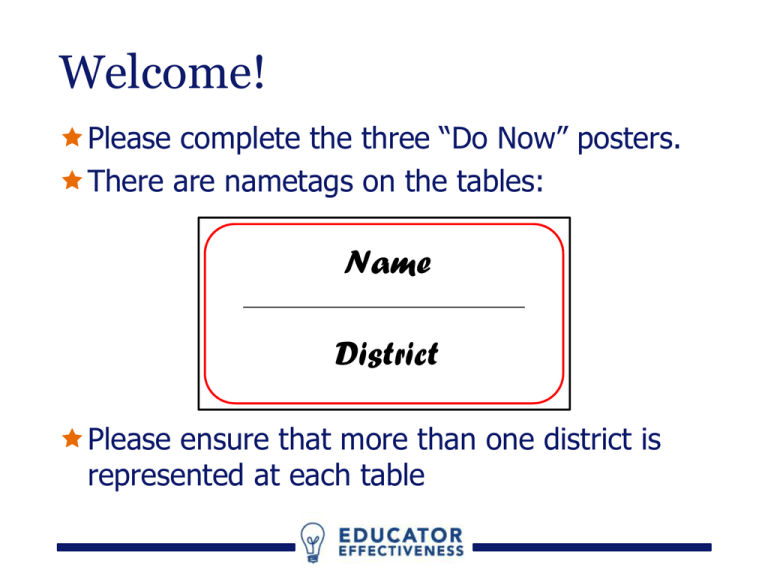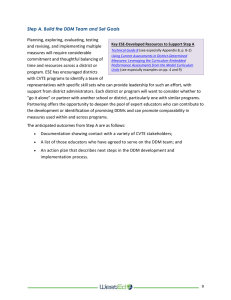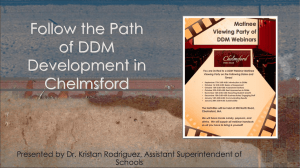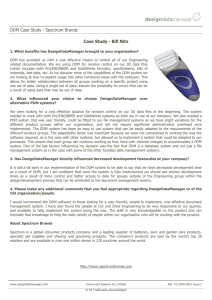Welcome! Name District
advertisement

Welcome! Please complete the three “Do Now” posters. There are nametags on the tables: Name District Please ensure that more than one district is represented at each table DDM Technical Assistance and Networking Session December 12, 2013 Today’s Agenda 2:30pm – 2:40pm 5:00pm -5:15pm Arrival and “Do Now” Poster Activities Table Talk 1 – Examining and Sharing Status of HS Writing-to-Text DDM Whole-group Share Presentation – Building a DDM Network Across Districts: Lessons from the Lower Pioneer Valley Educational Collaborative Gallery Walk Table Talk 2 – Writing-to-Text DDM Planning Poster and Networking Whole-group Share 5:15pm – 5:30pm Closing and Feedback Forms 2:40pm – 3:20pm 3:20pm – 3:30pm 3:30pm – 4:10pm 4:10pm – 4:25pm 4:25pm – 5:00 pm 2 Massachusetts Department of Elementary & Secondary Education Intended Outcomes Participants will: Connect with colleagues from other districts around the development of the HS Writing-to-Text DDM Grow your network of colleagues that you can work with beyond these TA meetings Identify opportunities and related next steps to collaborate with similarly situated districts 3 Massachusetts Department of Elementary & Secondary Education Table Talk 1 (40 min.) Conversation: At your table, reflect on each district’s progress developing and piloting a Writing-to-Text DDM See Agenda & Guiding Questions Take-aways should include: Areas of strength and challenge – reference poster Complete Table Talk 1 poster and prepare for whole-group share Massachusetts Department of Elementary & Secondary Education 4 Whole-group share (10 min.) HS Writing-to-Text DDM Areas of expertise and needed support 5 Massachusetts Department of Elementary & Secondary Education Developing a Regional Network for DDM Development: Writing to Text Field Example Technical Assistance Session 3 December 12, 2013 Background This is one example of a collaborative process used by multiple districts to develop a Writing-to-Text 10th grade DDM Objective: reflect on LPVEC’s process and consider ways in which you might leverage a similar network or collaborative to support your DDM development process District-Determined Measures Writing to Text Grade 10 Lower Pioneer Valley Educational Collaborative West Springfield Agawam Ludlow Southwick/Tolland/Granville East Longmeadow Longmeadow Hampden-Wilbraham Regional Easthampton North Brookfield DDM 4-Step Cycle 1. Plan 2. Develop 4. Implement 3. Revise 1. Plan Monthly Curriculum Directors’ meeting Scheduled three full days to develop our Writing to Text Grade 10 DDM District leaders invited English teachers, department heads, and classroom coaches – our content experts District leaders and instructors met face-toface for a full day to develop our rubric. Used email, Google Docs and Wikispaces for communication after the initial face-to-face. Reflection Questions: Plan Reflecting on LPVEC’s Work How did the LPVEC group’s planning work benefit from engaging a regional network? What key logistical components made the planning work feasible for the LPVEC group? What aspects of this collaborative planning process feel most high leverage for your district? Individual Notes 2. Develop All participating districts sent a team armed with the Massachusetts Curriculum Framework for ELA Presented information from MA DESE’s Teacher and Administrator’s Evaluation System regarding DDMs to understand impact rating. Content experts worked in groups to identify key College and Career Readiness standards to assess. 2. Develop, cont. Content Experts decided to go in a different direction than the planners had planned….. They identified critical criteria that they believed aligned to the CCRs they had chosen to include in the rubric. Planners re-wrote the afternoon’s agenda to assist working groups to develop levels of competencies for each section of the rubric. By the end of the day, groups reported out, and the group compiled the information to create a very rough rubric. The Rubric – One Component COMPONENT 4 STRONG 3 EFFECTIVE 2 DEVELOPING 1 NEEDS IMPROVEMENT Use of Evidence to Support Argument Evidence is explained in a thorough manner. The use of evidence exhibits insight (which means that the student fully grasps the inferences intended by the author) which is apparent by the use of explicit and implicit language and reasoning. Evidence is adequately used and is based on explicit and implicit textual support. Evidence is somewhat reasonably based on explicit textual support, but perhaps lacking in implicit textual support. Evidence is barely used in a coherent way, exhibiting a lack of understanding of the content. Evidence is explained using vague, unclear or ambiguous language and/or reasoning. The evidence provided does not address the writing prompt, and it appears to be illogical or incoherent. Evidence and explanation directly and thoroughly support claim/thesis. Evidence is explained using adequate language and reasoning. Reflection Questions: Develop Reflecting on LPVEC’s Work How did the LPVEC group’s development work benefit from engaging a regional network? What aspects of this collaborative development process feel most high leverage for your district? Individual Notes 3. Revise We recognized the need to homogenize the language throughout the rubric Curriculum Directors came together for this challenge. Our discussions led us to the understanding that our content experts needed to have the final voice. We posted a comment period. Reflection Questions: Revise Reflecting on LPVEC’s Work How did the LPVEC group’s revision work benefit from engaging a regional network? What aspects of this collaborative revision process feel most high leverage for your district? Individual Notes 4. Implement We are here! During this pilot year, we are collecting data. Methods for scoring include double blind scoring – this requires having anchor papers and training teachers in consistent scoring procedures. All processes are documented for technical manual. Reflection Questions: Implement Reflecting on LPVEC’s Work How do you see implementation of this collaboratively developed DDM as benefitting from the support of a regional network? What key logistical components made implementation of a collaboratively developed DDM feasible for each district? What aspects of this collaborative implementation stage feel most high leverage for your district? Individual Notes Thanks! Wikispace with supporting documents: http://lpvec-curriculum-page.wikispaces.com/DDM_Workshop_7_9_2013 Polly Parker Director of Curriculum/Staff Development Lower Pioneer Valley Educational Collaborative pparker@lpvec.org Gallery Walk/Transition (15 mins) Where do you see points of commonality in the development stage of other tables’ Writing-to-Text DDMs? 21 Massachusetts Department of Elementary & Secondary Education Table Talk Round 2 (35 min.) Identify and chart common priorities Determine up to five priorities the group will work together to address. Record up to three action steps for each priority Who will do what, when, and how? Where will group members meet, virtually or inperson? Which other districts might you invite to participate? Massachusetts Department of Elementary & Secondary Education 22 Whole-group share (15 min.) Share two of the areas of the DDM development and identification process that the group chose for collaboration 23 Massachusetts Department of Elementary & Secondary Education Thank you! Please complete the evaluation form on your way out. 24 Massachusetts Department of Elementary & Secondary Education


